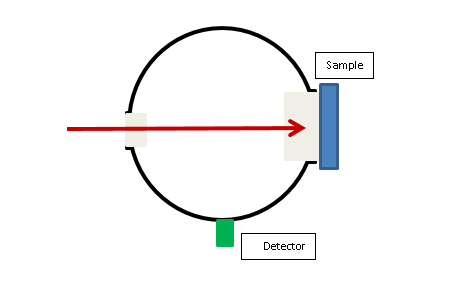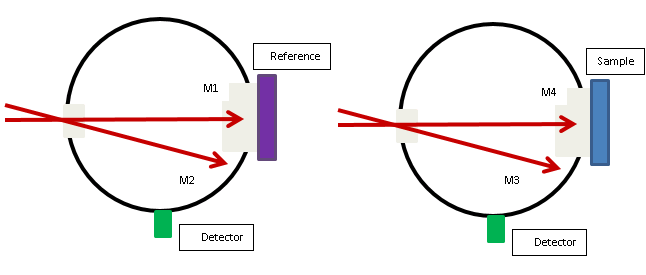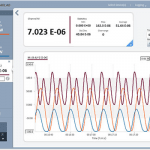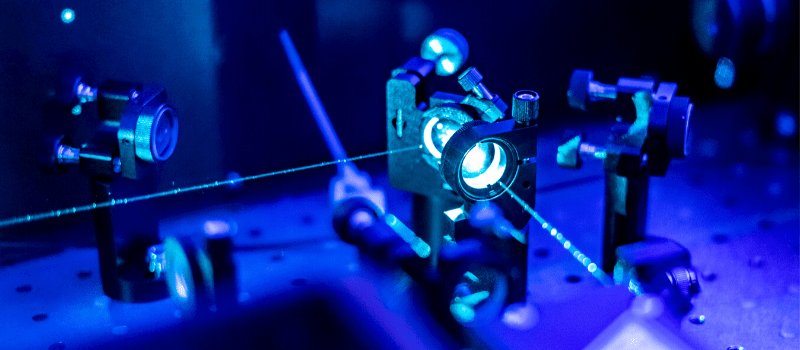How much light is scattering off of that? Most objects scatter light in all directions. How can we catch it all?
When light hits a mirror, it is reflected at an angle that is equal to the angle of incidence. This is specular reflectance. Most objects will also have light reflected or scattered in other directions. This is diffuse reflectance. In fact, the diffuse component usually predominates. Such objects are said to be matte. In an ideal matte surface, the luminous intensity varies as the cosine of the viewing angle and the reflection is said to be Lambertian.
Even mirrors can have a small fraction of incident light sent into diffuse reflectance. Alternately, some seemingly matte objects will have a significant fraction reflected in the specular direction.
It is fairly easy to measure the specular component because we know in what direction to look for it. However, to accurately measure the diffuse reflectance we must capture the light going in all directions. This is usually accomplished by use of an integrating sphere. An integrating sphere consists of a spherical chamber made from a highly reflective Lambertian reflector with small openings for introducing light or removing it for measurement.
Integrating spheres
Integrating spheres are useful for a variety of measurements and Ophir makes different configurations tailored to disparate ones. Diffuse reflectance measurements require the IS6 spheres with the C designation. These are 4 port spheres with three different options for detector (UV, Vis or IR).
There are two 1″ (25.4 mm) ports and a 2.5″ (63.5 mm) port in the equatorial plane and a 1″ port at the north pole. They are calibrated with collimated light entering the 1″ port in the equatorial plane, incident on a PTFE plug in the 2.5″ port across from it. The detector is attached to the remaining equatorial port.
To measure diffuse reflectance the sample must be brought in contact with the 2.5″ measurement port. If the sample is smaller than 2.5″, a port reducer should be used (e.g. P/N 7Z08305A). The surface to be measured will be illuminated from the 1″ entrance port on the opposite side of the sphere.

To include the specular component in the measurement ensure that the illuminating beam is incident at a slight angle (6° should suffice), otherwise the specular component is liable to exit back out of the entrance port. Occasionally we are interested in only the diffuse part of the reflectance. In this case (or if the specular component is known to be negligible), illumination incident at zero degrees should be used.
In all of these measurements care must be taken to get accurate readings. Although the spheres are calibrated, a sample of low reflectance will alter the sensitivity of the sphere noticeably (known as substitution errors). To measure such a sample accurately use a reference of known reflectance. If the reference and sample are of similar reflectance it is sufficient to directly compare the readings. Then,

where Rref is the reflection of the known reference and the M’s are the readings from the sample and reference.
If the reference and sample have appreciably different reflectance a slightly more elaborate technique can be used to avoid substitution errors. First, measure the reference and then redirect the illuminating beam to a particular spot on the sphere wall. Then, the reference can be substituted for the sample (preferably without disturbing the sphere) and additional measurements are recorded comparing illumination of the same spot on the sphere wall to illumination of the sample. The reflection of the sample is then equal to

where Rref is the reflection of the known reference and the M’s are the measurements described above. Mwall,samp refers to the reading with the illumination on the sphere wall while the sample is mounted in the sample port. In fact, with the illumination on the sphere wall, the change in reading between swapping the sample and reference (or the sample and the port plug) will give a measure of the substitution error.
With a little care, integrating spheres are the easiest way to get accurate measurements of diffuse reflectance.











Leave a Reply
Your email address will not be published. Required fields are marked *